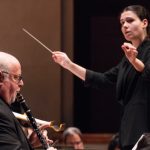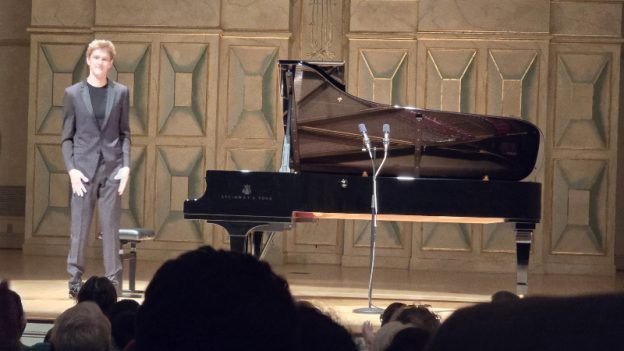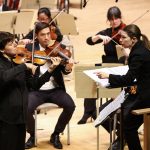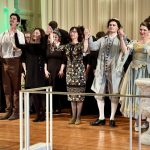November 22, 2025
Spivey Hall
Morrow, Georgia – USA
Jan Lisiecki, piano.
Frédéric CHOPIN: Prelude in D-flat major, Op. 28 No. 15 (“Raindrop”)
Frédéric CHOPIN: Preude in A-flat major, B. 86
Johann Sebastian BACH: Prelude in C minor from The Well-Tempered Clavier, Book I
Sergei RACHMANINOFF: Prelude in D minor, Op. 23 No. 3
Karol SZYMANOWSKI: Preludes, Op. 1
Olivier MESSIAEN: Preludes pour piano
Frédéric CHOPIN: Prelude in C-sharp minor, Op.45
Sergei RACHMANINOFF: Prelude in C-sharp minor, Op. 3 No. 2
Henryk GÓRECKI: Four Preludes, Op. 1
Johann Sebastian BACH: Prelude No.2 in C minor, BWV 847
Sergei RACHMANINOFF: Prelude in G minor, Op. 23 No. 5
Frédéric CHOPIN: Preludes, Op. 28 (complete)
William Ford | 26 NOV 2025
Spivey Hall, on the campus of Clayton State University in Morrow, GA, continues to attract some of the world’s leading pianists. This weekend, it presented the remarkable Canadian artist Jan Lisiecki in an ambitious program of forty-one preludes spanning Messiaen to Górecki and culminating in the complete Chopin Op. 28.
Full Disclosure
I rarely review concerts by artists I’ve interviewed. Conversations of real depth create a kind of relationship, especially when the artist shares personal history and early influences—material that inevitably shapes how one listens. But in this case, the assignment came first. I accepted the review weeks before the interview, and when the chance to speak with Lisiecki arose, it was impossible to turn down. Encounters with artists of this caliber—and generosity—are not opportunities one declines. To see the interview, go here: https://youtu.be/_5qq01wpaoQ?si=Ql-PIHQLxk25hXb4; to read an edited version, go here: https://www.earrelevant.net/2025/11/jan-lisiecki-on-discipline-performance-psychology-and-programming-for-his-spivey-hall-recital/
In conversation, he was exceptionally intelligent, self-aware, and analytically precise. At twenty-nine, he shows a clarity about his artistic decisions, future directions, and the consequences of each step that is rare at any age.
Critical Context: What Others Have Said
His current all-prelude recital tour has sparked unusually varied reactions in major music centers.
In London, reviews ranged widely. The Guardian admired the sweep and boldness of his playing while questioning the breadth of his softest dynamics. Others found the recital electrifying, especially the psychological intensity of the Górecki Preludes and the narrative cohesion of the Chopin cycle. One reviewer called the evening “stupendous,” emphasizing the emotional and architectural rigor he brought to the form.
In New York, writing about his Carnegie Hall recital, critics focused on the ambition of the program—moving through centuries of musical thought before centering everything on Chopin’s Op. 28. They praised his clarity of structure, direct phrasing, and the way he gives brief forms genuine narrative weight.
Even recording critics, responding to his recent Preludes album, noted the poised lyricism of his Chopin and the arresting intensity of his Górecki.
With these perspectives in mind, I approached his Spivey Hall performance with genuine curiosity: how would these intentional, analytically grounded ideas translate in performance?
The Recital
Lisiecki elected to play the entire program without breaks. This unusual decision kept his concentration—and ours—undisturbed by applause, allowing the evening to unfold as a single expressive arc. Tall, slender, and physically economical, he does not rely on theatrical gesture; his authority comes from refinement and discipline, not display.
Although Lisiecki’s tour is often described as an “all-prelude” journey, the first half of the Spivey Hall program was more intricate—and more surprising—than that shorthand suggests. Rather than beginning with Bach, as many of his other stops have done, he opened with Chopin: the familiar Prelude in D-flat Major, Op. 28 No. 15 (“Raindrop”), followed by another Chopin prelude of entirely different character. Starting the evening with two emotionally concentrated works immediately set a psychological frame before the program widened into Messiaen, Bach, Rachmaninoff, Górecki, and Szymanowski.
The ordering created a fascinating contour: a Chopin-centered starting point that cast its light backward and sideways through several centuries of musical language. Instead of progressing chronologically or grouping pieces by style, Lisiecki arranged the first half like a rotating prism—Romantic clarity refracted through Messiaen’s luminous colors, Bach’s crystalline architecture set against Górecki’s stripped-down volatility, and Szymanowski’s harmonic iridescence providing a dissolving close before intermission. The effect was not a collection of brief pieces but a single arc in which each composer’s voice illuminated, unsettled, or reframed the others.
Before moving deeper into the program, it is helpful to recall the worlds of two composers central to the evening:
- Karol Szymanowski (1882–1937) blended late-Romantic color with impressionistic harmony and Polish folk spirit, producing music that oscillates between sensuality and modernist edge.
- Henryk Górecki (1933–2010) emerged from the post-war avant-garde before turning toward a stark, deeply spiritual simplicity—emotionally direct but never simplistic.
Chopin → Messiaen → Bach → Rachmaninoff → Górecki → Szymanowski
Messiaen’s two preludes glowed with delicacy and transparency. Lisiecki shaped them with remarkable softness, revealing colors that emerged rather than declared themselves. His Bach—the C-minor Prelude from WTC I—was clean, luminous, and rhythmically supple, avoiding both rigidity and sentimentality.
Rachmaninoff’s Op. 23/3 and Op. 23/5 brought the first surge of weight. Lisiecki tightened tempos, expanded the dynamic range, and delivered their drama with architectural purpose rather than rhetorical heat. His rapid runs were so even they nearly shed the percussive identity of the piano.
Szymanowski’s brief preludes shimmered with iridescent clarity. Where these pieces can blur into chromatic haze, he brought out inner lines with surprising precision.
The Górecki Preludes: The Emotional Fulcrum
The Górecki Preludes formed the dramatic axis of the first half. This music, which can collapse into blunt insistence, became in Lisiecki’s hands a study in controlled volatility. Patterns tightened, surged, fractured, and dissolved with a sense of emotional rupture that felt purposeful rather than theatrical. Dynamics grew organically, not as sentimental gestures but as the natural consequence of internal harmonic tension.
These performances were intense but never angry, stark but never cold. They made the rest of the first half feel like a long inhalation and exhalation around a central point of psychological gravity.
Chopin’s Preludes, Op. 28
The second half was devoted entirely to Chopin’s twenty-four preludes—a mosaic of miniature emotional worlds that can easily fragment without a strong architectural vision. Lisiecki supplied that vision. His pacing—one prelude exhaling into the next, or breaking sharply when needed—gave the cycle narrative inevitability.
Highlights included:
- The fragile lyricism of No. 4 in E minor
- The unforced candor of No. 7 in A major
- A unified, unsentimental reading of the “Raindrop” (No. 15)
- The crystalline brilliance of No. 16 in B-flat minor
- The solemn weight of No. 20 in C minor
Some London critics questioned the breadth of his pianissimo. That critique did not hold here. His softest playing was centered, supported, and expressive—never tentative. His fortes were structural destinations, not percussive punctuation.
Conclusion
What impressed me most was the intellectual through-line. Lisiecki’s thinking—so precise and self-aware in conversation—was fully audible in performance. Every transition felt intentional, every shift of color belonged to a larger story, and every climax was earned. In a recital composed entirely of short forms, he demonstrated that brevity is not a limitation but a concentrated form of narrative power. This was not merely a recital of preludes; it was an exploration of the prelude as a way of thinking about compression, transformation, volatility, and calm. At twenty-nine, Jan Lisiecki plays with the insight of a far older musician and the energy of someone still searching.
And it must be said: this was a peak musical experience, heightened by the extraordinary acoustics of Spivey Hall. Designed with an almost uncanny balance of clarity and warmth, the hall proved to be an ideal partner for Lisiecki’s full dynamic spectrum—from the thunderous surges of Rachmaninoff and the volatile edges of Górecki to the whispered refinements of Messiaen and the inward poetry of Chopin. Nothing was blurred or overstated; every color and articulation spoke with immediacy. In a space where resonance never masks nuance, Lisiecki’s artistry emerged in its fullest light, confirming both the excellence of the artist and the hall that framed him.
His performance was met with thunderous applause and multiple curtain calls—an expression not of polite admiration, but of genuine excitement for a recital that felt both deeply considered and intensely alive. ■
EXTERNAL LINKS:
- Jan Lisiecki: janlisiecki.com
- Spivey Hall: spiveyhall.org

Read more by William Ford.
RECENT POSTS
 Dallas Symphony’s assistant conductor rises to the challenge in a program of premieres and familiar works • 25 Nov 2025
Dallas Symphony’s assistant conductor rises to the challenge in a program of premieres and familiar works • 25 Nov 2025 Tyshawn Sorey Trio and Sandbox Percussion merge forces in Durham for an immersive night honoring jazz drummer Max Roach • 24 Nov 2025
Tyshawn Sorey Trio and Sandbox Percussion merge forces in Durham for an immersive night honoring jazz drummer Max Roach • 24 Nov 2025




.png)